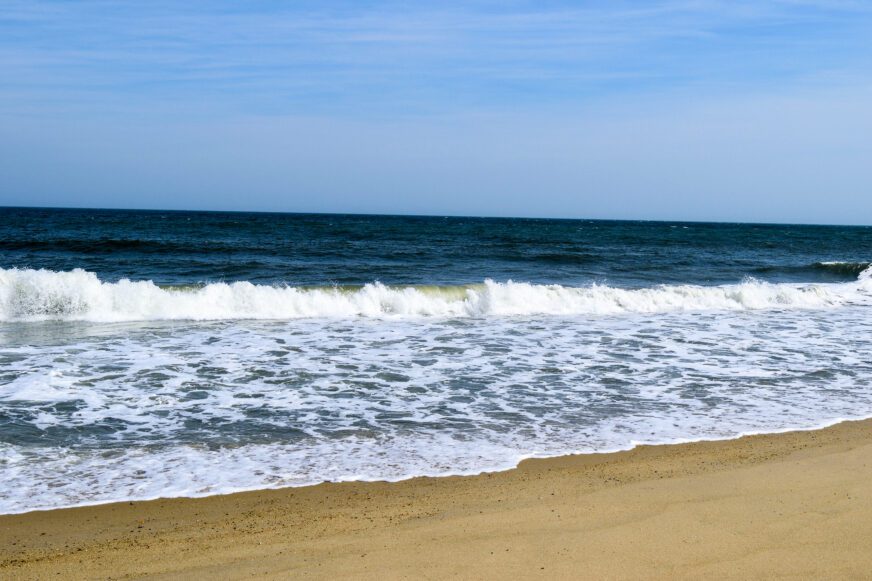The following is an excerpt from Queering Rehoboth Beach: Beyond the Boardwalk by queer historian James T. Sears and available June 11 from Temple University Press.
Rehoboth, which was established in the 19th century as a Methodist Church meeting camp, has, over time, become a thriving mecca for the LGBTQ+ community. Queering Rehoboth Beach is more than just an inspiring story about a community’s resilience and determination to establish a safe space for itself in the wake of the era of Don’t Ask, Don’t Tell. It is also a terrific beach read.

During the 1950s, Rehoboth became a furtive beach destination…
How about we take this to the next level?
Subscribe to our newsletter for a refreshing cocktail (or mocktail) of LGBTQ+ entertainment and pop culture, served up with a side of eye-candy.
From the 1950s and into the 1960s, closeted locals and DC government folks cruised secluded beach dunes or attended weekend afternoon cocktail parties with pitchers of Manhattans or martinis.
The most exclusive were near Silver Lake, at the summer home of Bob Gray, President Dwight Eisenhower’s appointments secretary, who was becoming DC’s most sought-after lobbyist. “His travels on the social circuit were so extensive,” detailed the Washington Post, that the gentleman who “smiled like a diamond” would wear out “two tuxes annually.”
Others hooked up at the Pink Pony, a Boardwalk bar owned by WWII veteran Ted Nowakowski Sr. that welcomed gays who mixed amiably with straights, especially during Saturday’s happy hour. There, behind the thick smoked-glass windows framed with latticework, homosexuals freely drank, dined, listened to cabaret, and occasionally danced.
Evelyn Dick Thoroughgood, whose grandfather, Allee Dick, was the second mayor of Rehoboth, had graduated from Rehoboth High School in 1938. She recalls her “first encounter with gay social life” in the 1950s. Stopping by one night to see her husband, George, who occasionally bartended and whom everyone called Bugs, “was the first time I had ever seen this wild, exhibitionist style of dancing.”
The Great Nor’easter of March 1962 washed away the original Pink Pony along with much of the Boardwalk. Gays sought other watering holes. One such bar was on First Street, just off Rehoboth Avenue. At first, the owner charged homosexuals double for drinks, but he later hired a spotter to identify and eject them.
Thirty-three-year-old Jimmy Short was one of those deviates. A former Coast Guard officer and high school history teacher, Short had just completed fifteen months at the New Castle County Workhouse—the last man jailed under Delaware’s sodomy statute. He met up with a bisexual couple, Ronald and Betty Godwin, at nearby Bethany Beach. They owned Nomad Village, a dozen A-frame cottages along with a liquor store and bar. Short convinced them to queer one side of their fledgling bar.
Secluded beaches immediately beyond the town’s northern and southern boundaries also harbored homosexuals. Caressed by ocean breezes thick with the smell of Hawaiian Tropic, they played volleyball and Frisbee, enjoyed backgammon and cards, and drank sea breezes and colas as Johnny Mathis and Lesley Gore crooned on transistor radios.
Away from the curious and outside local jurisdiction, their invisibility was shattered in the summer of 1964 when a Rehoboth man publicly exposed “widespread” homosexuality on its beaches. Harry Bonk, a former All-American who played halfback under the legendary Bear Bryant, told his fellow state highway commissioners, “They congregate like bees in a swarm.” A Rehoboth tavern owner backed up Bonk’s statement: “They come in groups of six or eight like a bus unloading.” It’s “an invasion.”
The Stonewall riots marked the emergence of queer underground newspapers, campus student unions, and community liberation groups. Even so, Rehoboth, like most towns in the Diamond State, appeared unchanged during the 1970s.
Gay sunbathers continued to stroll across “Carpenter’s Beach,” although there were no longer special holiday tables of food freely available to passersby, as sixty-eight-year-old Louisa Carpenter’s twin-engine jet, on route from her Florida horse farm, had stalled and crashed in a field near Easton, Maryland. This stretch of beach area was now roped off from the dunes to the tidemark; epithets or eggs were sometimes tossed at queer “trespassers.”
A growing number of gay men were quietly buying and renovating summer homes, retiring to the beach, and starting businesses. Ed Conroy and Roy Anderson had been visiting Rehoboth since the 1950s. Before the Chesapeake Bridge was constructed, Conroy remembers the DC-based couple’s time-consuming crossing of the bay in a ferry with their two dogs. Anderson recalls strolling the Boardwalk on summer nights: “You dressed. There were no shorts!”
For a brief time during the early 1960s, they had operated a seasonal shop, the Unicorn Gallery. In 1972, the DC educators and art couple bought a second home behind the old Henlopen Hotel near the beach, known as the Gables for its unique architectural style.
Four years later, on Fourth of July weekend, they opened an upscale gift shop. However, first they approached shop owner Ross Alexander to ensure that there would be no problems. “Do you mind if a shop opens up next to you?” Anderson recalls asking. “He said, ‘Not if we don’t sell the same things.’”
Unlike Joss, the Wooden Indian featured upscale Americana, such as pottery, decoys, blankets, and quilts, along with Herald and Waterford china and miniatures that the couple bought on their annual trip to London’s West End aboard the Queen Mary.
That same 1976 holiday weekend, twenty-something Michael Decker, a gifted musician who often toured with top rock groups, was listening to a popular local radio station. “Rock the Boat,” a disco hit by the Hues Corporation, played in the background. The announcer beckoned, “Cruise Down to the Boathouse.”
Decker recounts, “Any gay person hearing that music—if you weren’t listening to the speaking—would be attracted.” Homosexuals heeded this siren call and headed to Dewey Beach. The line of mustached men in denim, lusting to join disco dancers at three bars for a $3 cover, stretched two blocks, stopping just short of Rehoboth’s southern border, like the Douglass Hotel a century earlier.
Lesbians who enjoyed sunning themselves at North Beach also frequented Nomad Village or the Boathouse. Libby Stiff remembers “drinking screwdrivers with a splash of sloe gin. We called them Sloe Screws.”

Most lesbians, though, preferred private gatherings. Those with a bit of money could enjoy dinner or afternoon high tea at the newly opened Back Porch Café. Its closeted co-owner, Victor Pisapia, whose Italian grandparents had immigrated to the country and whose godparents had opened a restaurant in Dover, prepared such meals as fresh trout with mignonette sauce or jerk chicken—unseen on Rehoboth’s drone menus of fried foods and pizza.
A few, too, sojourned to the salon hosted by the magisterial Anyda Marchant and her partner, soft-spoken Muriel Crawford. The couple, together since 1948, had co-founded Naiad Press in 1973, which published Marchant’s pseudonymous lesbian novel, The Latecomer. On Saturday evenings, they imbibed Dewars on the rocks and served up cocktails mixed with lively conversations about literature, politics, and art, with an occasional flutist playing in the background.
On Memorial Day weekend in 1980, DC bar impresario Glen Thompson opened Renegade Disco & Lounge, West of Rehoboth. It was the first openly owned gay bar in Delaware. Unlike the dilapidated Boathouse, where cattails pressed against windows and bay waters sometimes seeped between wooden dance planks, his club provided a “first-quality” dance floor and sound system for a “multitude of sweaty bodies.”
The next summer, the Washington Blade proclaimed, “Crowds of younger, more ‘blatant’ Gays have discovered Rehoboth.” Renegade became “a conspicuous symbol of ‘the Gay presence.’”
The news story also featured the Blue Moon, which had opened on Baltimore Avenue, by owners Victor Pisapia and Joyce Felton. The gay child of Pisapia’s gastronomical gem—the Back Porch Café—and Felton’s Manhattan avant-garde eateries, this glitzy restaurant served nouvelle cuisine with New York panache.

Such brazen visibility of lesbians and gay men did not sit well with Rehoboth’s old guard, the town commissioners, or high-toned members of the Homeowners Association, whose political endorsement usually guaranteed election.
During the summer of 1981, Commissioner John Hughes’s political ads, paid for by the association, promised “the continuation of Rehoboth as a family resort.” The thirty-nine-year-old mayoral candidate espoused traditional values, warning, “Keep your eyes open when this family resort is advertised in other areas as a gay paradise!”
By the mid-1980s, the number of expressly gay-owned upscale restaurants, B&Bs, and shops had grown to more than a baker’s dozen. More followed, particularly along Baltimore Avenue, transforming it into a gay venue known simply as “the Avenue.”
Rehoboth, as headlined in the state’s leading newspaper, had joined the Atlantic Coast “summer circuit” of “vacation spots among gays: Provincetown, Key West, and Fire Island.”
Frustrated, Mayor Hughes, then seeking his third term, unabashedly told the Washington Blade that the town was “still not ready for the sight of two gays walking down the street with their hands in each other’s hip pockets.”
The advent of a “gay cancer” only heightened fear among Reagan-era Rehoboth citizens. Bumper stickers, funded by the Homeowners Association, proclaimed, “Keep Rehoboth a Family Town.”
Some local youth formed a wannabe heterosexual militia, the Anti-Gay Vigilante Organization. These young men brandished gay-phobic T-shirts and wielded ball bats, stoking fears among some within the nascent queer community.
Not surprisingly, incidents of harassment and assaults on gay men and women escalated. Graffiti scrawled outside known gay establishments, bottles tossed toward departing Renegade and Blue Moon customers, and epithets hurled at suspected queer beachgoers became far too common.
Near the decade’s end, the opening of a downtown gay dance club, the Strand, sparked wholesale rebellion among townsfolk, whose pitchforked elected officials sought to legislate it, if not homosexuals themselves, out of existence. The cover of the Washington Post Magazine—a stern-looking lifeguard gazing over sunbathers—declared “The Battle for Rehoboth.”
Throughout the 1990s, war waged. There were raids and arrests at gay bars, hastily drawn up ordinances targeting gay-owned businesses, and selective enforcement of laws for customers strolling along the Avenue.
Violent assaults by local youth were only slightly less unusual than harassment of queers from youthful cohorts of beach guards or summer police officers. These actions were met with resistance: boycotts of homophobic merchants, street celebrations of gay pride, outlandishly costumed men attending weekend themed parties, gay and lesbian candidates running for elected office, and local gay publications.
The founding of CAMP Rehoboth in 1991 by an odd assortment of gay men was the most significant, however. As this decade progressed, this nonprofit preached an inclusive—Create A More Positive—middle way. It provided sensitivity training to police recruits, sponsored community-wide AIDS fundraisers, reached out to ministers and merchants, and published the biweekly Letters. It also condemned explicit ads, erotic businesses, and overt displays of sexuality.
At the decade’s end, another story appeared in the Washington Post Magazine, butthis cover depicted two gay men holding hands, with the title “Rehoboth Beach and Its Gay Constituency, Coming to Terms.”
This excerpt is from Queering Rehoboth Beach: Beyond the Boardwalk by historian and educator James T. Sears, available June 11 from Temple University Press. Reprinted with permission.
Don’t forget to share:





